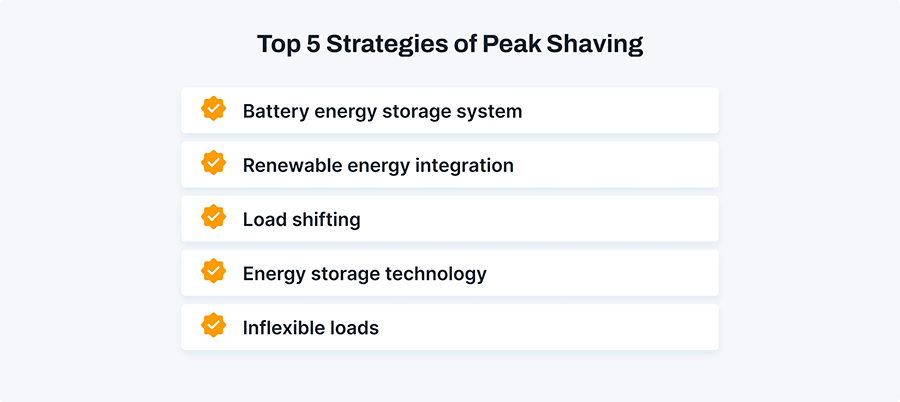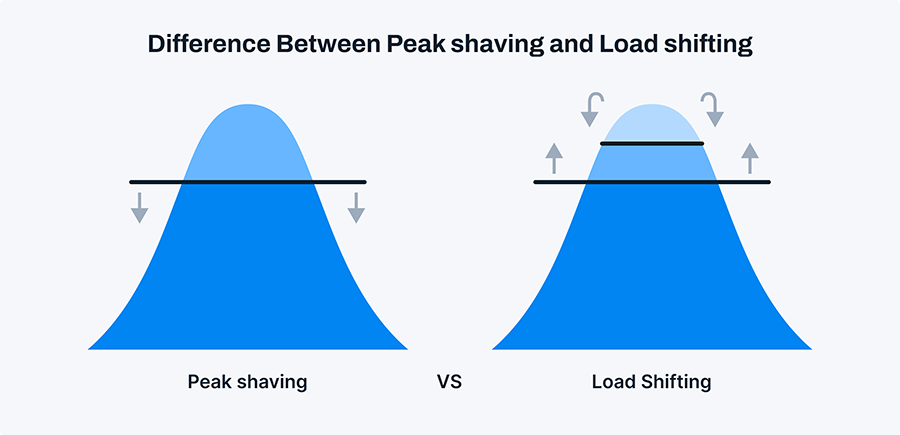Top 5 Strategies for Peak Shaving & How IoT Can Help
April 01, 2024Peek shaving is a clever thing for utilities and energy users to anticipate new approaches to load management to prevent blackouts and expensive rate increases. IoT is filtering and collecting information technology that monitors and administers power consumption around the clock. IoT devices report about the energy details, giving a glimpse to businesses and utilities on energy usage patterns to tweak their usage or prioritize activities in a way that demand is not peaking. This mutual effort is toward cutting their expenses, being more efficient, and maintaining the power supply network and distribution safe and stable.
What is peak shaving?
Peak shaving is very similar to operating your budget scales for electricity bills. Similarly to how one would make their spending match the capacity to preserve the finances in the shopping peak season, companies control their energy supply during high demand particular hours to save significant sums. Here comes energy management that is efficient to save money for the business.
The peak demand is the hours when customers need the quantity of electricity. The demand is higher when people in the house wake up and in the evening when they return home from work. This rapid increase in power consumption can create an imbalance in the electricity system and some cases may even lead to power failure and blackouts if the power supply isn't enough to satisfy the demand.
Peak shaving successfully demonstrates energy consumers can disconnect briefly from the power grid and reduce their power usage during these peak periods. The grid power usage is lowered by managing power consumption by scaling down on the power usage or using the stored energy accumulated by the battery. Another better option is to activate the non-grid power generation system on-site. In summary, this proceeding is the surgical removal of the top part of the power demand.
Top 5 peak shaving strategies

Peak shaving strategies are essential in energy management to reduce electricity demand during peak hours, enhance grid stability, and optimize energy consumption. Here are five strategies for peak shaving:
Battery energy storage system (BESS)
Energy Storage Systems (BESS) based on batteries serve as a base for electricity management. It is backed by the dynamic ability to store and discharge energy at the time when it is required. BESS can capture power from multiple sources and store it in rechargeable batteries. This green technology offers a dependable and adaptable power solution. It not only reduces carbon emissions but also provides cost-effective energy storage options. It means the stored energy remains accessible even during grid instability or extreme weather conditions.
Be it to smooth out the variability of renewable energy or to serve the purpose of a generator. This kind of technology, particularly in lithium-ion batteries, has highlighted BESS among the best energy storage options.
Renewable energy integration
Reintroducing renewable energy sources into the working power grids is the basic prerequisite for establishing a sustainable energy future. Adding resources such as wind, solar, hydropower, and geothermal sources helps to diversify the renewable energy mix and provide an environment-friendly alternative to fossil fuels. On the other hand, the realization of the plan is accompanied by difficulties including unpredictable weather conditions, a characteristic of renewable sources.
Sophistication in grid management technologies, including IoT sensors and machine learning, will hence occupy the most important place in remedying the problem of intermittent renewable energy sources and improving the overall efficacy of energy distribution. The advantages of undocking a renewable energy source are abundant, which include reduced greenhouse gas emissions, increased energy security, lower costs, and local economic support.
Load shifting
Load shifting, known as demand shifting, is one of the strategies to avoid facing peak demand altogether by moving the energy consumption from peak periods to non–peak times. This entails shifting energy-consuming tasks or operations to when electricity is needed usually at a minimum during the off-peak hours. Shifting business loads via off-peak time eliminates the need for maximum peak usage, thereby minimizing the amount of peak electricity use and subsequent energy costs.
Energy storage technology
Energy storage technology is like a power bank for businesses. It stores extra energy when demand is low, then releases it during peak hours when electricity is expensive. It helps companies reduce cost peak charges and rely less on the grid. They use batteries, flywheels, or pumped hydro systems to store and release energy efficiently, ensuring a stable and cost-effective power supply.
Inflexible loads
Inflexible loads are like the appliances at home that you can't easily control with a switch. They stick to their schedules, whether it's your air conditioner keeping you cool or the refrigerator keeping your groceries fresh. When it comes to peak shaving, these inflexible loads add to the challenge because they keep chugging along during high-demand times, pushing up costs and putting pressure on the grid. So, to shave those peaks efficiently, we need to get creative with managing these stubborn loads by tweaking their settings or running them when electricity is cheaper.
Benefits of peak shaving connection with IoT
The Internet of Things (IoT) based demand-response programs in peak shaving is a very innovative method that effectively cuts energy consumption during peak demand hours. IoT-based wireless sensory networks can monitor the equipment of a building round the clock (24/7) and, by these sensors, measure the energy consumption for individual devices including the building equipment like the heating ventilation, and air conditioning (HVAC) system or lighting systems. Utilizing real-time data provides a robust foundation for timely optimizations, ensuring reliable reduction of peak demand.
Peak shaving, in conjunction with IoT technology, offers a range of advantages in managing energy consumption effectively. There are some main benefits that you should know:
Real-time monitoring
Peak shaving real-time monitoring offers invaluable benefits through its seamless integration with IoT technology. Real-time monitoring provides operators with immediate insights into energy consumption patterns, equipment performance, and demand fluctuations, by continuously collecting and analyzing data from various devices and systems.
Dynamic adjustments
Peak shaving dynamic adjustments offer control of energy consumption. Energy usage patterns can be continuously analyzed, enabling automated adjustments to equipment operation based on current demand and pricing signals through sensors and smart devices. For example, based on weather forecasts, cooling systems can be activated earlier to pre-cool a building, reducing the need for high energy consumption during peak hours.
Load balancing
Load balancing involves distributing the energy consumption across different times of the day to avoid peaks in usage. IoT devices equipped with sensors and connected to smart grids can collect real-time data on energy consumption patterns. This data can then be analyzed to identify peak demand periods and adjust energy usage accordingly.
Incorporating intermittent IoT technology with peak shaving techniques is the smartest and most efficient substitution to minimize energy consumption in peak demand seasons. With the help of real-time data monitoring and automation, IoT technology enables a proactive approach to dynamic adjustments which helps to decrease peak demand, minimize energy rates, and generally increase energy efficiency in buildings.
Peak shaving vs. load shifting

Peak shaving and load shifting are strategies used to manage electricity demand but they also differ in their approach.
Peak shaving
Peak shaving involves reducing or trimming down the highest peaks of electricity usage during periods of high demand. This is achieved by implementing limits to energy consumption during peak hours, such as using energy storage systems, adjusting equipment schedules, or curtailing certain non-essential processes.
Load shifting
Load shifting focuses on redistributing energy consumption from peak periods to off-peak times when electricity demand and costs are lower. Instead of reducing overall energy usage, load shifting aims to shift the timing of energy-intensive activities to times when there is less strain on the grid or when electricity rates are lower. This can be done by scheduling tasks or processes to run during off-peak hours or leveraging energy storage to store excess energy for later use.
In general, while both peak shaving and load shifting aim to optimize energy usage and reduce costs, peak shaving targets the reduction of peak demand, whereas load shifting involves shifting energy consumption to different times of the day.
Conclusion
In summary, peak shaving strategies enhanced by IoT technology enable us to build smart methods to quench electricity consumption effectively. Through time-based monitoring, complex analytics, and smart automated controls, companies can create uniquely designed peak shaving schemes that suit their individual needs.
Through, for example, demand response programs, common energy storage setups, load management schemes, or integrating renewables, peak shaving can be carried out together with IoT so enterprises can cut expenses, improve grid stability, and also support environmentally friendly energy usage.
FAQ
What is the peak shaving rate?
The peak shaving rate is a specific charge applied by utility companies based on a building's maximum hourly power requirement over a billing cycle. This rate is multiplied by the kilowatt level to determine the actual amount charged.
What is peak shaving in load management?
Peak shaving in load management involves reducing electricity consumption during peak demand periods to alleviate stress on the power grid. By actively managing and curbing electricity usage during these demanding periods, aims to flatten the demand curve, and minimize costs.
What is the difference between peak shaving and load balancing?
Peak shaving focuses on managing peak loads directly during high-demand periods, reducing stress on the grid. Load balancing optimizes electricity usage based on price or grid conditions without targeting peak demand specifically.
What is the peak shaving strategy?
The peak shaving strategy aims to reduce electricity demand during peak hours when grid congestion and prices are high. By utilizing energy storage systems like batteries, flywheels, or thermal storage.
How does peak shaving reduce energy losses?
Peak shaving helps reduce energy losses by optimizing energy usage during periods of high demand, thereby reducing strain on the grid and minimizing inefficiencies in energy transmission and distribution.


